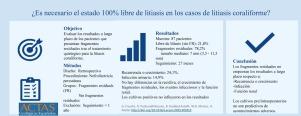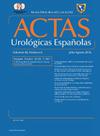珊瑚结石需要100%无石屑状态吗?
IF 1.2
4区 医学
Q3 UROLOGY & NEPHROLOGY
引用次数: 0
摘要
前言和目的评价鹿角石术后残留碎片患者的长期预后。材料与方法回顾性研究经皮肾镜碎石术治疗鹿角结石的患者并进行长期随访,分为残留结石组和非残留结石组。评估新结石或碎片生长情况、感染事件和肾功能。随访期少于一年的患者被排除在外。结果共纳入87例患者,其中女性占75.9%。其中,21.8%无结石,78.2%残留碎片,中位尺寸为7 mm (3.5-11.5 mm)。平均随访27个月(21 ~ 36个月)。仅有24.1%复发或残存碎片生长,中位生长10 mm (6-12 mm)。此外,14.9%的患者在随访期间发生尿路感染。无结石患者与残留碎片患者在复发、残留碎片生长、感染事件或肾功能恶化方面无显著差异。同样,当比较阳性或阴性培养的患者时,也没有发现差异。结论有无残留结石患者的复发、残留碎片生长、感染事件和肾功能恶化的发生率相当。此外,术前或术中培养阳性并不影响这些结果。本文章由计算机程序翻译,如有差异,请以英文原文为准。

¿Es necesario el estado 100% libre de litiasis en los casos de cálculos coraliformes?
Introduction and objectives
To evaluate long-term outcomes in staghorn stone patients with residual fragments following surgical treatment.
Materials and methods
A retrospective study of patients who underwent percutaneous nephrolithotripsy for staghorn stones and long term follow up were divided into two groups: residual stones versus non-residual stones. The occurrence of new stones or fragment growth, infectious events, and renal function were evaluated. Patients with a follow-up period of less than one year were excluded.
Results
A total of 87 patients (75.9% female) were included in the study. Of these, 21.8% were stone-free, while 78.2% exhibited residual fragments with a median size of 7 mm (3.5-11.5 mm). The average follow-up period was 27 months (21-36 months). Only 24.1% experienced recurrence or growth of residual fragments, with a median growth of 10 mm (6-12 mm). Additionally, 14.9% of patients developed urinary infections during the follow-up period. No significant differences were observed between stone-free patients and those with residual fragments in terms of recurrence, residual fragments growth, infectious events, or deterioration in renal function. Similarly, no differences were noted when comparing patients with positive or negative cultures.
Conclusions
The incidence of recurrence, growth of residual fragments, infectious events, and deterioration of renal function was comparable between patients with and without residual stones. Furthermore, the presence of positive preoperative or intraoperative cultures did not influence these outcomes.
求助全文
通过发布文献求助,成功后即可免费获取论文全文。
去求助
来源期刊

Actas urologicas espanolas
UROLOGY & NEPHROLOGY-
CiteScore
1.90
自引率
0.00%
发文量
98
审稿时长
46 days
期刊介绍:
Actas Urológicas Españolas is an international journal dedicated to urological diseases and renal transplant. It has been the official publication of the Spanish Urology Association since 1974 and of the American Urology Confederation since 2008. Its articles cover all aspects related to urology.
Actas Urológicas Españolas, governed by the peer review system (double blinded), is published online in Spanish and English. Consequently, manuscripts may be sent in Spanish or English and bidirectional free cost translation will be provided.
 求助内容:
求助内容: 应助结果提醒方式:
应助结果提醒方式:


